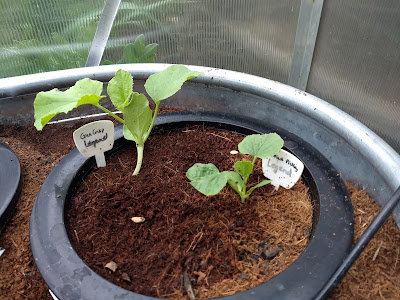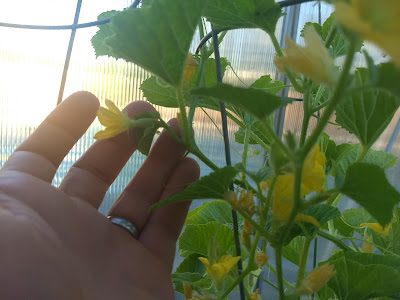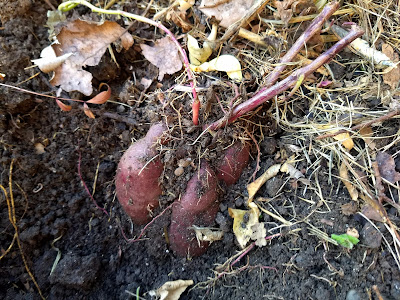Friday, February 18, 2022
Emanuele Larosa’s primarily Dark Carosello Leccese
Friday, February 11, 2022
SeedSelect Strikes again with a Spotted Spuredda Leccese
Of all the Italian seed companies I have acquired seed from SeedSelect has to be the most mixed-up of them all. In all the times I have grown their varieties, I honestly don’t recall ever getting a fruit that looked exactly like what was on the label. Sometimes this can be extremely frustrating. If I were a regular gardener, this kind of inconsistency would drive me crazy. However, if there is sufficient biological deviance, beautiful things can happen.
My friend Giuseppe grew out a Carosello Barese several years ago that had flecked dark spots on them. While the fruit was beautiful, we were unfortunately not able to save the seed – even after I tried growing out many seeds from the same packet. For all I knew, the flecked Carosello Barese was lost to the world.
Given that there is generally a high level of variability with carosello cucumbers and given that I had observed some really off-type cucumbers from SeedSelect before, I decided to try growing out the Spuredda Leccese SeedSelect once again. Not knowing that I could produce anything like my friend’s flecked Leccese, I planted a couple more seeds of this variety and hoped for the best.
Imagine my delight when I began seeing flecks on the skin. I was so very happy. While in gardening, I have come to better understand the carosello and other immature C. melo cultivars, this was just an incredibly fortunate tender mercy. I was both surprised an honored by the gift of a second chance. I did all I could to save the seed and pass it on to my friend, Giuseppe.
While there is still a possibility that my friend and I could lose the speckled or flecked Spuredda Leccese again, I truly hope that we can preserve it to be enjoyed by future generations.
Friday, February 4, 2022
The Bitter Truth about Asian Pickling Melons
Occasionally I do variety trials. One of the variety trials I decided to conduct was a pickling melon variety trial. For this one, I grew out all of the pickling melons that I could find and grew them out to their first true set of leaves. Then I tasted the leaves for bitterness. All but two of the pickling C. melo varieties that I grew had very bitter leaves (a clear indication that bitter fruit would follow). So I only grew those varieties out for a short while.
The least bitter pickling melons were spared and grown until they were much larger. At this point, I tasted the leaves and stems and found them to be bitter, so I pulled them too.
Friday, January 28, 2022
Sweet Potatoes in the Garden
Each year I save the very best sweet potatoes to plant for the following season for growing out sweet potato slips. I have found that by utilizing my clay ollas using my EasiOyYa setup (https://www.indiegogo.com/projects/easioyya#/comments), I am able to provide a steady source of moisture for my sweet potatoes.
All I do is set the sweet potatoes in the ground lengthwise near each olla, then I water them once by hand. Then I wait. As the sweet potato slips pop out of the ground, I make sure to select slips that have strong healthy growth. Slips consist of both the top growth (the stem and leaves) as well as the roots that begin growing below ground from the stem. For the most part, once the sweet potato is harvested, no roots or further growth occurs from the original mother sweet potato unless the new slips provide energy to them. When I lived in Tucson and had warmer soil temperatures, I found it easiest to grow sweet potatoes by starting the tuber in the ground and removing the potato once the slips have grown large enough. However, now that I live in an area with cooler soil temperatures, I find it advantageous to start my slips where I know that the soil temperature remains consistently warm.
Starting slips can be relatively easy. In very hot climates, you can shade the transplants for a day or two to allow them to get established. Because the leaves do not transpire as much as many other vegetable varieties, most transplants should be successful. Even a relatively small end of stem can be successfully transplanted into the ground to make a completely new plant.
While I generally start my transplants around June 1st (something I have been doing since living in Tucson), you may need to start your transplants a little later if you live in a much cooler climate. Short-season productive varieties may do better in climates with a short season. For nearly a decade, I have been utilizing Dingess Purple. I settled on this variety after a trail with half a dozen purple sweet potato varieties. It had the best flavor and texture of any of the sweet potatoes I grew and it makes a fabulous purple sweet potato pie.






















































